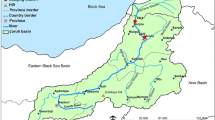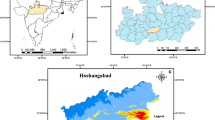Abstract
Streamflow forecasting can have a significant economic impact, as this can help in water resources management and in providing protection from water scarcities and possible flood damage. Artificial neural network (ANN) had been successfully used as a tool to model various nonlinear relations, and the method is appropriate for modeling the complex nature of hydrological systems. They are relatively fast and flexible and are able to extract the relation between the inputs and outputs of a process without knowledge of the underlying physics. In this study, two types of ANN, namely feed-forward back-propagation neural network (FFNN) and radial basis function neural network (RBFNN), have been examined. Those models were developed for daily streamflow forecasting at Johor River, Malaysia, for the period (1999–2008). Comprehensive comparison analyses were carried out to evaluate the performance of the proposed static neural networks. The results demonstrate that RBFNN model is superior to the FFNN forecasting model, and RBFNN can be successfully applied and provides high accuracy and reliability for daily streamflow forecasting.








Similar content being viewed by others
References
Box GEP, Jenkins GM (1970) Time series analysis: forecasting and control, revised ed. Holden-Day, San Francisco, USA
Simon Haykin (1999) Neural networks: a comprehensive foundation, p 842
Afan HA, El-Shafie A, Yaseen ZM et al (2014) ANN based sediment prediction model utilizing different input scenarios. Water Resour Manag 29:1231–1245. doi:10.1007/s11269-014-0870-1
Alp M, Cigizoglu HK (2007) Suspended sediment load simulation by two artificial neural network methods using hydrometeorological data. Environ Model Softw 22:2–13. doi:10.1016/j.envsoft.2005.09.009
Kisi O, Dailr AH, Cimen M, Shiri J (2012) Suspended sediment modeling using genetic programming and soft computing techniques. J Hydrol 450–451:48–58. doi:10.1016/j.jhydrol.2012.05.031
Rai RK, Mathur BS (2008) Event-based sediment yield modeling using artificial neural network. Water Resour Manag 22:423–441. doi:10.1007/s11269-007-9170-3
Roushangar K, Mehrabani FV, Shiri J (2014) Modeling river total bed material load discharge using artificial intelligence approaches (based on conceptual inputs). J Hydrol 514:114–122. doi:10.1016/j.jhydrol.2014.03.065
Shiri J, Kişi Ö (2012) Estimation of daily suspended sediment load by using wavelet conjunction models. J Hydrol Eng 17:986–1000. doi:10.1061/(ASCE)HE.1943-5584.0000535
Daliakopoulos IN, Coulibaly P, Tsanis IK (2005) Groundwater level forecasting using artificial neural networks. J Hydrol 309:229–240. doi:10.1016/j.jhydrol.2004.12.001
Sulaiman M, El-Shafie A, Karim O, Basri H (2011) Improved water level forecasting performance by using optimal steepness coefficients in an artificial neural network. Water Resour Manag 25:2525–2541. doi:10.1007/s11269-011-9824-z
Cigizoglu HK, Alp M (2004) Rainfall-runoff modelling using three neural network methods. Methods 3070:166–171
Unal B, Mamak M, Seckin G, Cobaner M (2010) Comparison of an ANN approach with 1-D and 2-D methods for estimating discharge capacity of straight compound channels. Adv Eng Softw 41:120–129. doi:10.1016/j.advengsoft.2009.10.002
Karimi S, Kisi O, Shiri J, Makarynskyy O (2013) Neuro-fuzzy and neural network techniques for forecasting sea level in Darwin Harbor, Australia. Comput Geosci 52:50–59. doi:10.1016/j.cageo.2012.09.015
Kisi O, Akbari N, Sanatipour M, Hashemi A, Teimourzadeh K, Shiri J (2013) Modeling of dissolved oxygen in river water using artificial intelligence techniques. J Environ Inf 22:92–101
Talento S, Terra R (2013) Basis for a streamflow forecasting system to Rincón del Bonete and Salto Grande (Uruguay). Theor Appl Climatol 114:73–93. doi:10.1007/s00704-012-0822-8
Taylor P, Campolo M, Soldati A, Andreussi P (2003) Artificial neural network approach to flood forecasting in the River Arno. Hydrol Sci J 48:381–398
Kagoda PA., Ndiritu J, Ntuli C, Mwaka B (2010) Application of radial basis function neural networks to short-term streamflow forecasting. Phys Chem Earth 35:571–581. doi:10.1016/j.pce.2010.07.021
Shiri J, Kisi O (2010) Short-term and long-term streamflow forecasting using a wavelet and neuro-fuzzy conjunction model. J Hydrol 394:486–493. doi:10.1016/j.jhydrol.2010.10.008
Wu JS, Han J, Annambhotla S, Bryant S (2005) Artificial neural networks for forecasting watershed runoff and stream flows. J Hydrol Eng 10:216–222. doi:10.1061/(ASCE)1084-0699(2005)10:3(216)
El-Shafie A, Abdin AE, Noureldin A, Taha MR (2009) Enhancing inflow forecasting model at Aswan high dam utilizing radial basis neural network and upstream monitoring stations measurements. Water Resour Manag 23:2289–2315. doi:10.1007/s11269-008-9382-1
Danandeh Mehr A, Kahya E, Şahin A, Nazemosadat MJ (2014) Successive-station monthly streamflow prediction using different artificial neural network algorithms. Int J Environ Sci Technol. doi:10.1007/s13762-014-0613-0
Hosseinzadeh Talaee P (2014) Multilayer perceptron with different training algorithms for streamflow forecasting. Neural Comput Appl 24:695–703. doi:10.1007/s00521-012-1287-5
Maier HR, Dandy GC (2000) Neural networks for the prediction and forecasting of water resources variables: a review of modelling issues and applications. Environ Model Softw 15:101–124
Brown M, Harris CJ (1995) A perspective and critique of adaptive neurofuzzy systems used for modelling and control applications. Int J Neural Syst 60(2):197–220
Broomhead DS, Lowe D (1988) Radial basis functions, multi-variable functional interpolation and adaptive networks (No. RSRE-MEMO-4148). Royal Signals and Radar Establishment Malvern, United Kingdom
Moradkhani H, Hsu K, Gupta HV, Sorooshian S (2004) Improved streamflow forecasting using self-organizing radial basis function artificial neural networks. J Hydrol 295:246–262. doi:10.1016/j.jhydrol.2004.03.027
Bishop CM (1995) Neural networks for pattern recognition. J Am Stat Assoc. doi:10.2307/2965437
Ripley BD (2007) Pattern recognition and neural networks. Cambridge university press, Cambridge
Zhang GP, Patuwo EB, Michael YH (1998) Forecasting with artificial neural networks: the state of the art. Int J Forecast 14:35–62. doi:10.1016/S0169-2070(97)00044-7
Acknowledgments
The authors appreciate so much the financial support received by the second and sixth authors via DIP-2012-03 project funded from Universiti Kebangsaan Malaysia.
Author information
Authors and Affiliations
Corresponding author
Rights and permissions
About this article
Cite this article
Yaseen, Z.M., El-Shafie, A., Afan, H.A. et al. RBFNN versus FFNN for daily river flow forecasting at Johor River, Malaysia. Neural Comput & Applic 27, 1533–1542 (2016). https://doi.org/10.1007/s00521-015-1952-6
Received:
Accepted:
Published:
Issue Date:
DOI: https://doi.org/10.1007/s00521-015-1952-6




